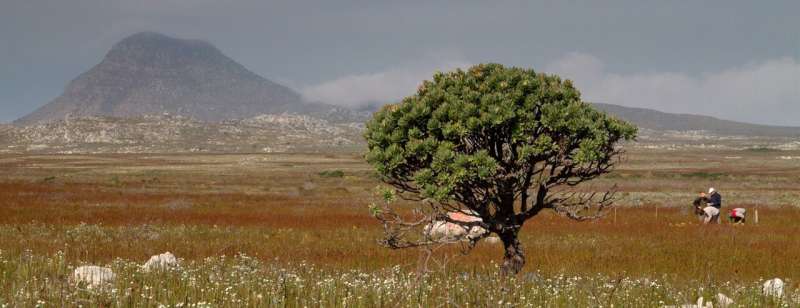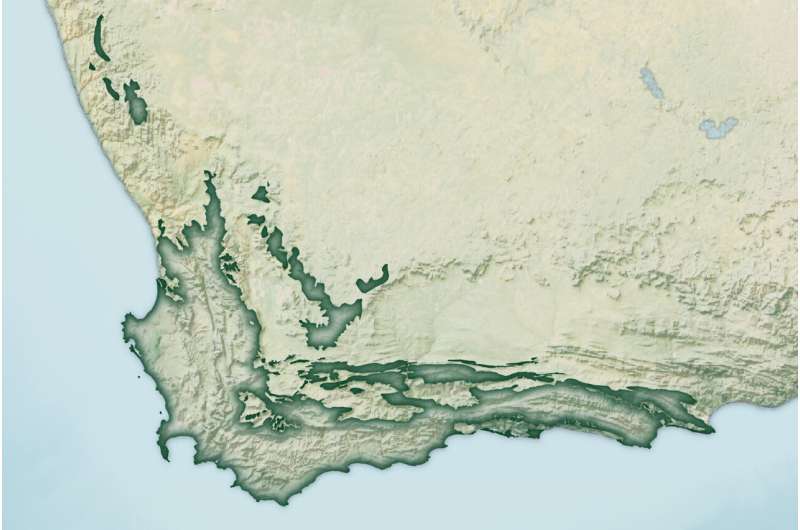This article has been reviewed according to Science X's editorial process and policies. Editors have highlighted the following attributes while ensuring the content's credibility:
fact-checked
trusted source
proofread
NASA aids international team studying one of the world's most diverse ecosystems

NASA satellite and airborne tools aid an international team studying biodiversity on land and in the water around South Africa.
An international team of researchers spent October and November 2023 in the field studying one of the world's most biologically diverse areas—South Africa's Greater Cape Floristic Region. As part of the effort, researchers used NASA airborne and space-based instruments to gather complementary data to better understand the unique aquatic and terrestrial ecosystems in this region. Their findings will inform the capabilities of future satellite missions aimed at studying plants and animals.
"The food we eat, the clean water that we drink, and the air we breathe comes from the diversity of life on planet Earth," said Erin Hestir of the University of California, Merced, and the campaign's lead aquatic researcher. "As we lose species, we're potentially losing Earth's ability to sustain healthy human societies and provide healthy food and clean water for all."
Known as the Biodiversity Survey of the Cape (BioSCape), the effort is a large collaboration led in the U.S. by NASA, the University at Buffalo in New York, and the University of California, Merced. It is led in South Africa by the University of Cape Town and the South African Environmental Observation Network.
The Greater Cape Floristic Region covers about 2.5 million acres (1 million hectares) on South Africa's southwestern tip. Home to many plant and animal species found nowhere else on Earth, the biodiversity hotspot is recognized as a World Heritage Site by the United Nations Educational, Scientific, and Cultural Organization (UNESCO). The area also includes several UNESCO Biosphere reserves to protect unique terrestrial and aquatic environments.
The BioSCape team is testing how well airborne and satellite remote sensing can characterize the region's terrestrial, freshwater, and marine biodiversity. Space- and airplane-based instruments can cover more ground—and do so faster as well as more frequently—than crews in the field. This has a wide range of practical applications, from mapping the presence of invasive plants to better understanding the drivers of harmful algal blooms.
A challenging area
"South Africa is a hugely biodiverse place, but it's a very challenging environment in which to do remote sensing research," said Anabelle Cardoso, BioSCape science team manager at the University at Buffalo and the University of Cape Town. "With so many plant and animal species packed into a relatively small area, using remote sensing instruments to differentiate between species living in close proximity can be difficult."
Three of the BioSCape aircraft sensors are imaging spectrometers, which observe different wavelengths of visible and infrared light reflected or emitted by various materials on Earth's surface and in the atmosphere. Each material has its own spectral fingerprint, enabling researchers to tell what they are observing.

For example, the dominant vegetation in the Greater Cape Floristic Region is a type of shrubland known as fynbos, which contains thousands of plant species. "We want to know whether the spectral signatures from these closely related fynbos variations are different enough that we can tell them apart in the data," said Kerry Cawse-Nicholson, a research scientist at NASA's Jet Propulsion Laboratory in Southern California.
"The discrimination of the biodiversity of phytoplankton in coastal and inland waters with imaging spectrometer data would advance science on aquatic ecosystem dynamics," said Liane Guild, a research scientist at NASA's Ames Research Center in California's Silicon Valley. It would do this by offering new insights on land-water interactions, including riverine plumes, runoff, sedimentation, and algae blooms in coastal and inland waters that could have impacts on food security.
Remote sensing capabilities like these will be vital for future satellites, such as the Surface Biology and Geology mission being planned for NASA's Earth System Observatory.
A more complete picture
BioSCape crews collected data on land and in the water, efforts that include conducting plant and animal surveys and taking environmental DNA samples. Their findings will both augment and help confirm species information gathered by four NASA airborne instruments and two of the agency's space-based instruments.
Mounted on airplanes, the Airborne Visible/Infrared Imaging Spectrometer—Next Generation, the Hyperspectral Thermal Emission Spectrometer, and the Portable Remote Imaging Spectrometer are managed by JPL. Their detection of spectral fingerprints ranges from the ultraviolet part of the spectrum through the visible and into the infrared. Combined, their data provides information to help differentiate species and study water quality in reservoirs, among other things.
Managed by NASA's Goddard Space Flight Center in Maryland, the fourth airborne instrument is the Land, Vegetation, and Ice Sensor, which uses laser technology, known as lidar, to construct a 3D representation of the land surface and vegetation. That data can provide information on the structure of vegetation—including tree and plant height and the internal layers of forests—as well as the ground topography beneath tree cover. This data will also help calibrate and inform current and future space-based lidars, such as the Global Ecosystem Dynamics Investigation currently operating on the International Space Station and a potential mission to study surface topography and vegetation.
In addition, the BioSCape team is using observations from two JPL-managed instruments on the space station. NASA's ECOsystem Spaceborne Thermal Radiometer Experiment on Space Station measures land surface temperature and can be used to assess plant stress due to temperature or water availability. The imaging spectrometer EMIT, short for Earth Surface Mineral Dust Source Investigation, gathers data on surface minerals, among other things, lending insight into the geology of the Greater Cape Floristic Region.
"One of the really exciting things is that when we combine the spectroscopy and the 3D structure, we can get a detailed biochemical and structural picture of the ecosystem," said Adam Wilson of the University at Buffalo and one of the campaign's lead researchers. This could help identify which plant species live in various environments, the presence of invasive plants, and how vegetation recovers after a wildfire.
The data collected by BioSCape has the potential for wide-ranging research and applications, particularly for the people of South Africa. The project was designed in collaboration with several South African institutions, as well as national and provincial park systems, which plan to incorporate data and analyses from BioSCape into management of natural resources.
More information: To learn more about BioSCape, see www.bioscape.io/home
Provided by NASA



















